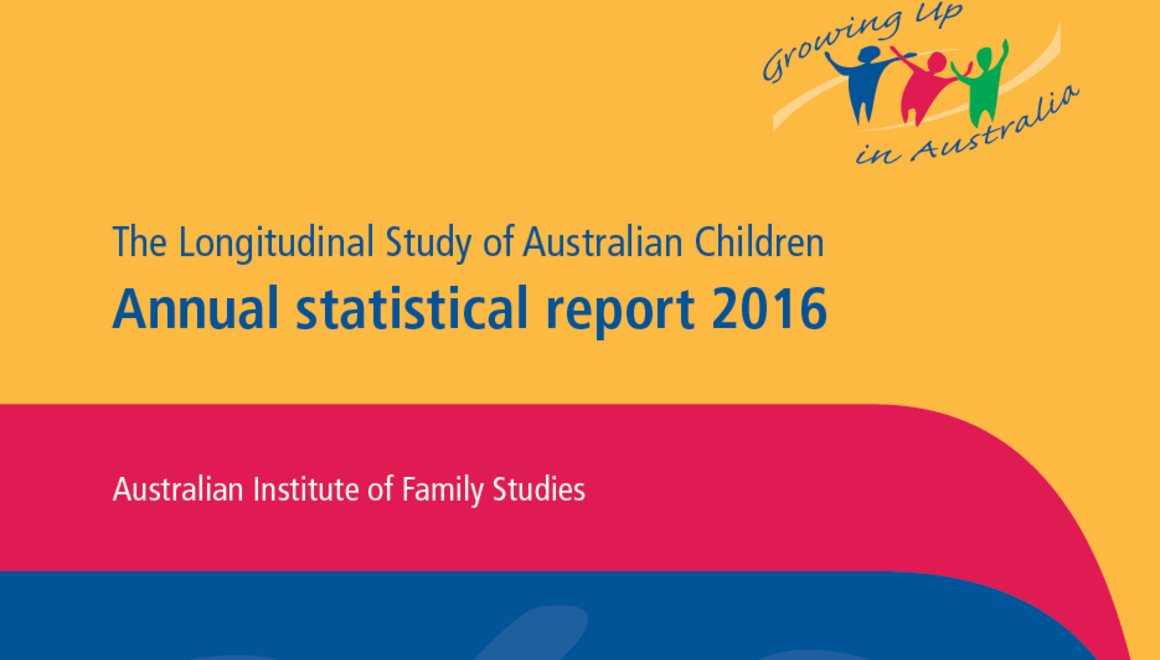Annual statistical report 2016
Annual statistical report 2016

Growing Up in Australia: The Longitudinal Study of Australian Children (LSAC) is Australia's first nationally representative longitudinal study of child development.
The purpose of the study is to inform research into the development and life-course trajectories of Australian children and young people.
The longitudinal nature of the study (involving repeated observations over time) enables researchers to examine the dynamics of change through children’s lives, thereby giving policy-makers and researchers access to quality data about child development in contemporary Australia.
This is the seventh volume in the LSAC Annual Statistical Report series, which uses data from the first six waves of the study. The purpose of the annual reports is to provide a snapshot of some of the data from the LSAC study, in order to address policy-relevant questions about Australian children and their families. The reports describe the dynamics of change as children develop, looking at how they—and their families—change through time.
Contents
1. Introduction and overview of LSAC data
Study purpose and design.
2. The career aspirations of young adolescent boys and girls
Jennifer Baxter
The career aspirations of 14-15 year old adolescents, in terms of the sorts of jobs they see themselves doing as adults, are explored in this chapter. How do career aspirations vary by gender, educational experiences and socio-economic characteristics? The analysis shows, for example, that while some jobs, such as doctors and architects, were ranked highly by boys and girls, career aspirations were highly gendered.
3. Teen employment experiences
Jennifer Baxter and Diana Warren
This chapter explores the employment of teens at 12-13 and 14-15 years, and how child and family characteristics are associated with patterns of employment. It looks at which teens are working, how much they are working and when. For example, while rates of teen employment were lower among those in lower socio-economic families, when these teens were in employment, they were more likely to be working longer hours.
4. Parental influences on adolescents' alcohol use
Jacqueline Homel and Diana Warren
This chapter examines the association between parents' drinking and the drinking of their 14-15 year old children, exploring how this relationship differs by the gender of each parent and their adolescent. The role of parental monitoring in the relationship between parents' and adolescents' drinking is also considered. The results confirm that parents' risky drinking is associated with early adolescent drinking.
This chapter provides new information about the number of Australian children who are providing informal care, how much time they spend providing care and the types of care provided. The study also explores various aspects of the lives of young people who care for a person with a long-term disability or health condition; from caring activities involving very limited assistance, through to the provision of two or more hours of care on a daily basis. With these extra responsibilities, young carers have significantly lower scores in NAPLAN reading and numeracy than their peers.
6. Self-harm and suicidal behaviour of young people aged 14–15 years old
Galina Daraganova
The prevalence rates of self-harm and suicidal behaviour among 14-15 year olds, the risk factors associated with these behaviours and the extent to which poor socio-emotional health earlier in life is associated with self-harm and suicide attempts are explored in this chapter. The results highlight that self-harm and suicidal behaviour are serious and often hidden problems, with some teens being more at risk of self-harm than others and present experiences of young people being the driving force of such behaviour.
7. Teaching practices in Australian primary schools
Suzanne Vassallo, Galina Daraganova, Gary Zhenyu Zhang and Jacqueline Homel
Are there differences in teaching practices according to the year level of the student and characteristics of the school, teacher and class? The findings indicate that teachers worked in different ways according to the age of their students, the school where they worked, the structure and composition of their class, and their own characteristics. Three main aspects of teaching practice are explored: whole group versus other forms of instruction; approaches to teaching maths and reading; and the use of within-class grouping.
8. Maternal age and family circumstances of firstborn children
Lixia Qu and Ruth Weston
This chapter explores differences in the home experiences of children over a ten-year time period, according to the mother's age when she had her first child. The findings indicate that the gaps in educational attainment and employment between mothers who started childbearing at early ages and those who started at later ages continued to hold but had diminished over the subsequent ten years.
Authors and Acknowledgements
The Australian Institute of Family Studies thanks the Australian Government Department of Social Services (DSS) for funding this report, and the DSS LSAC team for their contribution.
We wish to acknowledge the valuable comments of our independent reviewers on earlier versions of specific chapters including:
- Myra Hamilton, Social Policy Research Centre, University of NSW;
- John Hattie, Melbourne Graduate School of Education, University of Melbourne;
- Christine Millward, Parenting Research Centre;
- Wendy Patton, Faculty of Education, Queensland University of Technology;
- Chris Ryan, Melbourne Institute of Applied Economic and Social Research, University of Melbourne;
- John Toumbourou, Faculty of Health, Deakin University; and
- Stephen Zubrick, Telethon Kids Institute, University of Western Australia.
We also gratefully acknowledge the enormous contribution of the families and teachers who participated in the study.
This report uses unit record data from Growing Up in Australia: The Longitudinal Study of Australian Children. The study is conducted in partnership with the Australian Institute of Family Studies, with advice being provided by a consortium of leading researchers at research institutions and universities throughout Australia. The Australian Bureau of Statistics (ABS) conducts the data collection.
This report has been compiled and written by staff at the Australian Institute of Family Studies.1 The views expressed in this report are those of the individual authors and should not reflect those of DSS, AIFS or the ABS.










